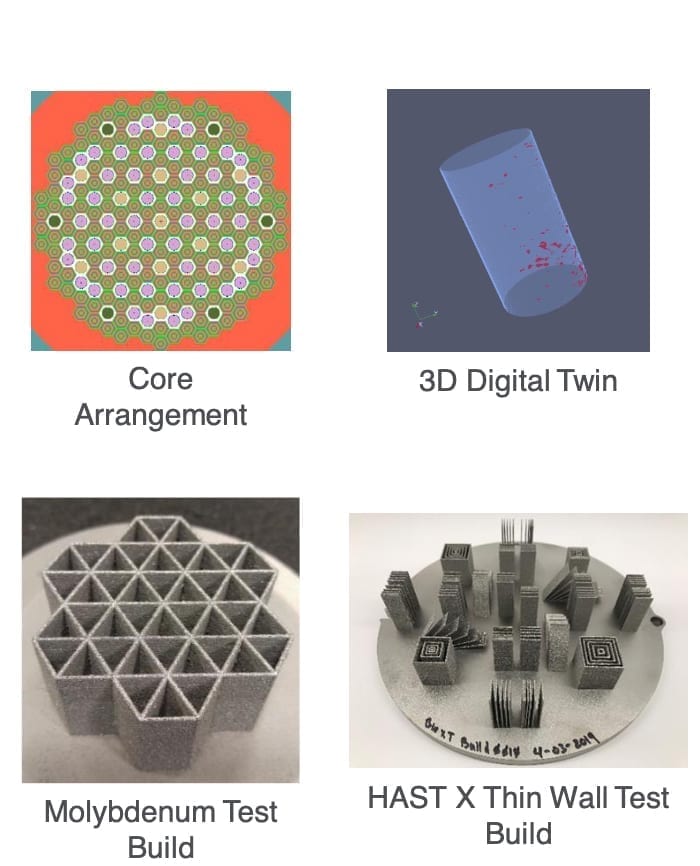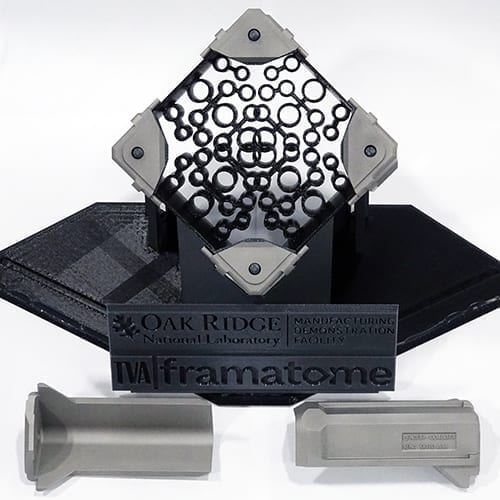BWXT: 3D Printing Breakthrough Could Speed Advanced Nuclear Reactor Development
BWX Technologies (BWXT) on Nov. 23 said it has demonstrated the ability to additively manufacture nickel-based super alloys and refractory-metal-based alloys for use in nuclear components. The company also said it has “accomplished component-level qualification, leading to a more efficient certification of nuclear materials configured in complex geometries.”
The 3D printing breakthroughs achieved through a collaboration with Oak Ridge National Laboratory (ORNL) could help speed up development of advanced nuclear reactors, which are often designed to operate at very high temperatures. Refractory metal alloy-based core components are thought to enable advanced reactors to reach core exit temperatures of 2,700F and overall plant efficiencies of approximately 50%.
But the breakthroughs also promise to improve efficiencies for the current commercial nuclear fleet, which have made notable headway in testing accident-tolerant fuel designs.
3D Printing Reshaping High-Temperature Component Manufacturing
“Additive manufacturing technologies will be transformational for the nuclear industry because they enable the creation of shapes not possible with conventional manufacturing techniques,” BWXT explained. “Additionally, verifying the ability to additively manufacture high-temperature super alloys and refractory metals enables designs that possess improved thermal energy management, increased safety margins and accident-tolerant characteristics.”
The company’s component-level qualification achievement, notably, is part of a $10 million project BWXT and ORNL began in 2018. Under that project, the team used a combination of in-situ process monitoring technologies, modeling, and data analytics to develop processing conditions for Hastelloy X and molybdenum for use in reactor core and other primary system components.
Hastelloy X is a nickel-base alloy with exceptional strength and oxidation resistance up to 2,200F that is already in use in furnace applications. Meanwhile, because molybdenum has a very high melting point, a low coefficient of thermal expansion, and a high level of thermal conductivity, it is already used in many different industries, such as to produce ribbons and wires for the lighting industry, semiconductor base plates for power electronics, glass melting electrodes, and hot zones for high-temperature furnaces.
As recent project documents suggest, BWXT purchased a novel “electron-beam melting” (EBM) additive manufacturing machine to perform a non-destructive and destructive examination on complex geometries developed by the 3D build process for Hastelloy X and molybdenum. The machine is an Arcam EBM Spectra H unit made by GE Additive. BWXT suggested that the EBM has several benefits over other additive manufacturing technologies, including a “low risk of contamination due to processing in a vacuum,” and pre- and post-heating, which allows for builds “to be performed at elevated temperatures.”

A collaboration between BWXT and Oak Ridge National Laboratory sought to establish an integrated advanced manufacturing and data science–driven paradigm for advanced reactor systems. Shown above are some major achievements outlined in a December 2019 presentation. Courtesy: BWXT
BWXT Seeking Risk Reduction Award
BWXT on Monday said it is planning to use the advanced manufacturing capability to reduce the costs of advanced nuclear energy systems. “BWXT expects to reduce manufacturing risk over time as outlined in its recent proposal to the Department of Energy’s Advanced Reactor Development Program (ARDP),” it said.
The DOE’s ARDP selections—two to five award winners for $30 million in appropriated funding—under the program’s “risk reduction for the future demonstration projects pathway” is slated for December.
The DOE in October chose TerraPower and X-energy to each receive $80 million in initial federal funding under the first ARDP pathway to build their two distinct advanced nuclear reactors and begin operating them within seven years. Energy Secretary Dan Brouillette then told reporters that the DOE intends to follow up the initial $160 million in funding (which Congress appropriated for Fiscal Year 2020) with future announcements. In total, the DOE intends to invest $3.2 billion in the ARDP program over the next seven years, as long as it receives future appropriations from Congress. In December, it may also announce $20 million in initial year funding awards for two advanced reactor concepts (ARC 20) under the third ARDP pathway.
Under the first ARDP announcement this October, X-energy, notably, will leverage the award to deliver a commercial-scale fuel fabrication facility for its proprietary TRISO-X TRi-structural ISOtropic particle fuel (TRISO) fuel, technology it developed under the 2015 DOE Advanced Gas Reactor (AGR) Fuel Qualification Program. TRISO is a specialized nuclear fuel that experts say is needed to meet emerging demand from Department of Defense microreactors; NASA, for nuclear thermal propulsion requirements; and civil advanced reactors.
BWXT’s own TRISO activities, however, are also notable. On Nov. 10, the company said its Nuclear Operations Group had completed its TRISO nuclear fuel line restart project, which means the company’s Lynchburg, Virginia, facility is now actively producing fuel.
BWXT Restarts TRISO Nuclear Fuel Manufacturing
BWXT has told POWER it worked with the DOE for more than 15 years under the AGR program to develop and manufacture TRISO-coated kernels at the specialty fuel facility to support the government’s vision of developing “passively safe, compact nuclear reactors capable of economically generating electricity and hydrogen.” Before it ceased TRISO production in the spring of 2017, BWXT had manufactured and certified TRISO-coated kernels and fuel compacts in production-scale quantities, it said.
In June 2020, BWXT announced a contract with Idaho National Laboratory to expand BWXT’s TRISO manufacturing capacity and produce a demonstration quantity of the fuel. That project is jointly funded by the U.S. Department of Defense’s (DoD’s) Operational Energy Capabilities Improvement Fund Office and NASA, with overall program management provided by the DoD’s Strategic Capabilities Office (SCO). In March, notably, the DoD’s SCO selected BWXT as one of three microreactor developers (along with Westinghouse and X-energy) to begin design work on a mobile nuclear reactor prototype under an initiative it has dubbed “Project Pele.”
Also in March, meanwhile, BWXT signed a contract with ORNL to demonstrate capability to manufacture TRISO nuclear fuel to support the continued development of ORNL’s Transformational Challenge Reactor (TCR). The scope of BWXT’s contract for the TCR includes the fabrication and delivery of uranium kernels, TRISO-coated surrogate materials, and TRISO-coated uranium kernels for a demonstration batch.
A Separate Materials Breakthrough for ORNL’s 3D-Printed Nuclear Microreactor
As POWER has reported in detail, the TCR is a first-of-its-kind nuclear reactor that will use a 3D-printed core, advanced materials, and integrated sensors and controls. It is on track for completion by 2024.
On Nov. 13, ORNL announced it had developed a system to fabricate large quantities of solid yttrium hydride—a rare earth metal and hydrogen mixture that will be used as a moderator for the TCR. Development of the material is much-watched because it promises to effectively slow down fission neutrons at high-temperature operating conditions of an advanced reactor’s core and allow for a compact core design.
“The new moderator is piquing the interest of numerous microreactor programs and could also open up opportunities with NASA as it develops new space reactors and propulsion systems,” ORNL told POWER.
To achieve optimal performance as a high-temperature moderator, the yttrium hydride “must be a flawless solid piece,” it explained. “Any cracks in the material can decrease thermal conductivity and impact the release of hydrogen. Yttrium hydride is not commercially available in a solid form, so scientists created a system in just 10 months to mass produce flawless pieces at a scale required for TCR.”
The system includes a high-temperature, high-vacuum furnace that can process the exact specifications to fabricate large-scale solid-metal hydrides. It also establishes “a reliable database with detailed information that fully captures its specific characteristics.” Finally, the process identifies the thermal, mechanical, and neutron scattering properties to better determine yttrium hydride’s stability within a nuclear reactor core.
ORNL Gearing Up to Test 3D Components at TVA Nuclear Plant
ORNL’s additive manufacturing work at the TCR, meanwhile, may be tested at the Tennessee Valley Authority’s (TVA’s) Browns Ferry nuclear plant as “early as this spring,” the lab said. ORNL in October partnered with TVA and nuclear supplier Framatome, to introduce 3D-printed channel fasteners for the fuel assembly at Browns Ferry by spring 2021.

Channel fasteners are a type of bracket attached to the top of the assembly to hold the channel that wraps around the assembly and guides coolant flow up through the bundle. ORNL said the component was chosen in part because it has “a straightforward, though non-symmetric, geometry and is a relatively simple part—ideal for a first-of-a-kind demonstration of additive manufacturing, in which material is deposited in layers, following a computer-designed model, to form precise shapes without the need for later carving or machining.”
The project represents two first-of-a-kind demonstrations: “the first-ever additively manufactured safety-related parts to go into a nuclear reactor, and the first physical parts that have ‘digital twins,’ or exact virtual models, created using TCR’s advanced monitoring and artificial intelligence techniques while being manufactured,” the lab said.
It also noted that although additive manufacturing may turn out to be a more cost-effective way to manufacture the part—which is typically cast and machined—the project will crucially serve as a “test case” for TCR’s digital platform. A key priority at TCR is to target a method to quickly certify the quality of components that will go into nuclear reactors, said ORNL’s Ryan Dehoff, section head for Secure and Digital Marketing.
—Sonal Patel is a POWER senior associate editor (@sonalcpatel, @POWERmagazine).